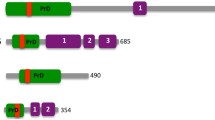Abstract.
Prion diseases are neurodegenerative disorders associated with a conformational conversion of the prion PrP protein, in which the β-strand content increases and that of the α helix decreases. However, the structure of the pathogenous form PrPSc, occurring after conformational conversion of the normal cellular form PrPC, is not yet known. From sequence analysis, we have previously proposed that helix H2 of the prion PrPC structure might be a key region for this structural conversion. More recently, we identified the TATA box-binding protein fold as a putative scaffold that may locally satisfy the predicted secondary-structure organisation of PrPSc. In the present analysis, we detail the schematic construction of PrPSc monomeric and dimeric models, based on this hypothesis. These models are globally compatible with available data and therefore may provide further insights into the structurally and functionally elusive PrP protein. Some comments are also devoted to a comparison of the yeast Ure2p prion and animal prions.
Similar content being viewed by others
Author information
Authors and Affiliations
Additional information
Received 29 July 2002; received after revision 24 October 2002; accepted 24 October 2002
RID="*"
ID="*"Corresponding author.
Rights and permissions
About this article
Cite this article
Mornon, JP., Prat, K., Dupuis, F. et al. Structural features of prions explored by sequence analysis. II. A PrPSc model. CMLS, Cell. Mol. Life Sci. 59, 2144–2154 (2002). https://doi.org/10.1007/s000180200014
Issue Date:
DOI: https://doi.org/10.1007/s000180200014




